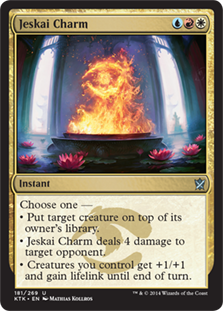When it comes to designing a game, one of the most important aspects is cohesiveness. If a game is too tightly bound to its framework and leaves little room for the players to make weighted decisions, then the game can become repetitive and lose the interest of its audience. On the other hand, if the game is poorly structured, providing too few restraints or guideposts for players to work towards, the experience can feel weak and ineffective. Finding that happy medium can be the most difficult part, for not only does that differ from one title to the next, but if it’s not properly addressed it can significantly impact its own worthiness.
Games like Magic are even more tricky, because finding that proper balance doesn’t just differ from year to year or set to set as new cards are added, but each format also possesses its own desired equilibrium. For instance, although there are certainly times when having too many choices is just as problematic as having too few, multiplayer Magic decks usually benefit from suffering the former more than the latter. Smaller more streamlined decks are the ideal goal for any competitive Constructed or two-player bout as the quicker, leaner, and more efficient you can make it, the higher the likelihood you will win the battle. Multiplayer formats like EDH are more like a grand melee of arcane wizardry, replete with constantly changing dynamics. You see rivals rise and fall, enemies become allies, and a battlefield with constantly changing weaponry being bandied about. To best face that reality head-on, you want as many options as possible to prepare for and handle the unexpected.
How each player and each deck addresses that will vary wildly, however, based on factors like theme, colors, level of redundancy, and utility.
The concept of utility cards – those that serve multiple purposes – have been addressed several times before in this series. This is not by accident, as many of these cards come in quite handy under the various circumstances they’ve been created for. Thanks to the modal nature of the various ‘charm’ and ‘command’ style spells, many of these cards are incredibly advantageous, even if their individual components don’t seem all that impressive.
This week’s pick is another card from this useful group – and it also just happens to have a certain topical color scheme to boot.
Today we have: Jeskai Charm

Name: Jeskai Charm
Edition: Khans of Tarkir
Rarity: Uncommon
Focus: Creature Bounce / Direct Damage / Life Gain
Highlights: There have been quite a few charm cycles over the years. Some, such as the Ravnica guild charms, continue to be fruitful. Others, such as the Onslaught tribal charms, haven’t held up as well. It’s a little early to determine the longevity of the Tarkir charms just yet, but among them, Jeskai Charm is arguably among the top two in contention for the most versatile and well-rounded of the bunch.
As with all of this group of wedge charms, the Jeskai Charm costs a mere three mana to cast, albeit of three different colors. This does limit the card’s scope to those running at least Red, White, and Blue, but in the middle to late stages of a game that should be a non-issue. (If it is, you probably have bigger problems to deal with.)
What it offers in return are three disparate but beneficial spells that each tie into their respective colors, all at instant speed. The first allows for you to not only bounce a creature (usually your opponent’s) from the board, but to actually send it to the top of their library, costing them a valuable creature and a wasted card draw in the process. This alone makes the card worth looking at, as it’s a highly undervalued but effect that can severely mess with the tempo of someone’s deck if appropriately timed, and at instant speed that’s doubly true.
The second effect is your standard direct damage option, allowing you to deal a straight 4 damage to a player or planeswalker. Four damage isn’t likely to single-handedly win you the game, but as any Red mage will attest, having access to a quick 4 damage – especially for planeswalker disruption – is well worth the three mana investment.
Finally you gain the option of a temporary creature buff and life gain by granting your creatures +1/+1 and lifelink for the turn. This can be helpful on either side of combat, be it if you’re attacking another player with several of your creatures or as blockers to help staunch potential life loss. Plenty of cards provide minor buffs or temporary lifelink to your army, but few are able to swing both effects at once, let alone at instant speed and the discount cost being offered.
Jeskai Charm may be a bit of a stapled together style charm, given that there isn’t a huge overlap of abilities, but while some may scoff at that from a flavor perspective, from a utilitarian approach that is anything but a negative. Each component part contributes in its own way, addressing specific threats and giving you a better, more comprehensive means of handling the various challenges you may encounter. Indeed, each individual aspect of Jeskai Charm may be functional if rather unremarkable, but when put together, its value goes well beyond the mere sum of its parts.
Which, you know, from a meta perspective, is also a nice holiday bonus too.
Keep an eye out for us to be regularly featuring other more accessible-but-worth-it Commander cards going forward. In the meantime, we’ll keep the light on for you.
![]()
You can discuss this article over on our social media!
